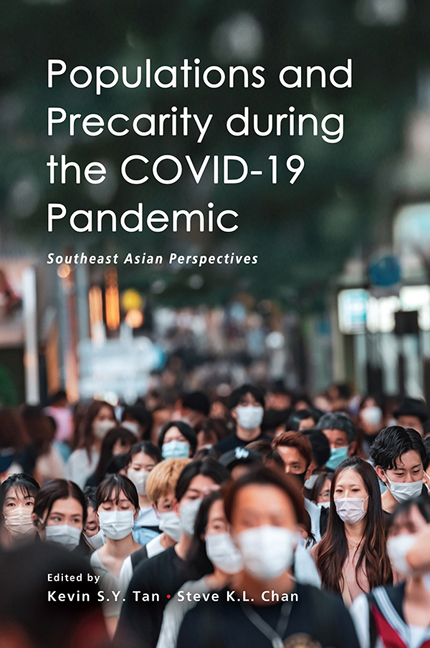Book contents
- Frontmatter
- Contents
- Preface
- About the Contributors
- 1 Introduction: Populations, Precarity and the COVID-19 Pandemic
- 2 Transformation of the Family Structure in Southeast Asia: Trends and Implications
- 3 New Normal, Old Ties: COVID-19’s Social Impact on the Singapore-Johor Bahru Connection
- 4 Unequal Flows: Examining the Factors Surrounding Thai and Vietnamese Labour Migration to South Korea
- 5 Emplacing Multiculturalism: Southeast Asian Migrant Linguistic Acculturation Programmes and Community Building in South Korea
- 6 “Foreign Talent” in Singapore and Some Implications for Schools
- 7 Managing Disaster Risk and Enabling Social Protection in Thailand: Some Lessons from the COVID-19 Pandemic
- 8 Transnational Housing Insecurity: Mobility, Homelessness, and the COVID-19 Pandemic
- 9 Older Persons with Hearing Disabilities in Indonesia: Vulnerability and Demographic Diversity during the COVID-19 Pandemic
- Index
2 - Transformation of the Family Structure in Southeast Asia: Trends and Implications
Published online by Cambridge University Press: 01 March 2024
- Frontmatter
- Contents
- Preface
- About the Contributors
- 1 Introduction: Populations, Precarity and the COVID-19 Pandemic
- 2 Transformation of the Family Structure in Southeast Asia: Trends and Implications
- 3 New Normal, Old Ties: COVID-19’s Social Impact on the Singapore-Johor Bahru Connection
- 4 Unequal Flows: Examining the Factors Surrounding Thai and Vietnamese Labour Migration to South Korea
- 5 Emplacing Multiculturalism: Southeast Asian Migrant Linguistic Acculturation Programmes and Community Building in South Korea
- 6 “Foreign Talent” in Singapore and Some Implications for Schools
- 7 Managing Disaster Risk and Enabling Social Protection in Thailand: Some Lessons from the COVID-19 Pandemic
- 8 Transnational Housing Insecurity: Mobility, Homelessness, and the COVID-19 Pandemic
- 9 Older Persons with Hearing Disabilities in Indonesia: Vulnerability and Demographic Diversity during the COVID-19 Pandemic
- Index
Summary
Introduction
All three demographic components—births, migration, and mortality— influence multiple aspects of families and households. Southeast Asia has witnessed substantial demographic changes notable of which are steep declines in fertility, increase in both intra-regional and international migration, and considerable lengthening of life expectancy. While the family continues to be a central institution, many aspects of the family are changing. Demographic literature on the causes and consequences of family change in the region is limited. At a more fundamental level, what constitutes a family during times of demographic change, as observed by Farris (2020, p. 4) in a different context, needs to be redefined to “include any group of people who are unified, cooperative, and care for each other”.
Using census and survey data from seven countries in the region and reviewing demographic reports between 1980 and 2017, this chapter examines demographic changes and their linkages to transformations in the family structure in the region. The chapter highlights the changes in family structure resulting from later marriage, greater marital instability, delay in young people leaving home, and a growing number of older persons.
Demographic Changes in Southeast Asia
Changes in births, migration, and life expectancy are discussed first. This is followed by an extended discussion of changes in marriage. Although marriage is not a formal demographic component (as it cannot directly alter population size or structure), it is closely tied to births in the region. Most births in the region occur within marriage, and the institution of marriage has not lost its relevance.
Declining number of children. In just over three decades, the average fertility rate has declined from more than five to replacement levels in most of the region (United Nations 2019b). Even in countries with relatively higher fertility, such as the Philippines, fertility has been declining though at a gradual pace. The declines have been attributed to various factors from the success of family planning programmes to economic development. One key reason for the decline is the impressive expansion of education, especially for girls, which has led to delays in marriage and brought about ideational changes regarding family sizes (Hull 2012).
- Type
- Chapter
- Information
- Populations and Precarity during the COVID-19 PandemicSoutheast Asian Perspectives, pp. 12 - 27Publisher: ISEAS–Yusof Ishak InstitutePrint publication year: 2023



